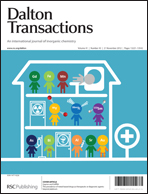The synthesis and characterisation of microporous coordination polymers containing copper(II) or cobalt(II) and 2-(pyridin-4-yl)malonaldehyde (Hpma) is described and the gas adsorption properties evaluated. Single-crystal X-ray structure determinations identified the structures as 3∞[M(pma)2]·2X (M = Cu, 1; Co, 2; X = MeOH, MeCN), which contain 3D networks with rutile topology and continuous 1D rectangular channels with diameters ranging from 3 to 4 Å. The materials exhibit low BET surface areas of 143 m2 g−1, but possess large capacities for carbon dioxide capture of 14.1 wt%. The small pore channels are shown to account for this, delivering a particularly strong binding enthalpy to adsorbed CO2 of 38 kJ mol−1, and a very large adsorption capacity relative to the low surface area.
You have access to this article
 Please wait while we load your content...
Something went wrong. Try again?
Please wait while we load your content...
Something went wrong. Try again?


 Please wait while we load your content...
Please wait while we load your content...